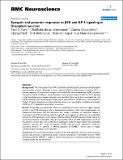| dc.contributor.author | Narayanan, Radhakrishnan | |
| dc.contributor.author | Navratilova, Zaneta | |
| dc.contributor.author | Patel, Chirag | |
| dc.contributor.author | Bohmann, Dirk | |
| dc.contributor.author | Ramaswami, Mani | |
| dc.contributor.author | Jasper, Heinrich | |
| dc.contributor.author | Etter, Paul D. | |
| dc.date.accessioned | 2010-09-29T19:40:15Z | |
| dc.date.available | 2010-09-29T19:40:15Z | |
| dc.date.issued | 2005-06 | |
| dc.date.submitted | 2005-03 | |
| dc.identifier.issn | 1471-2202 | |
| dc.identifier.uri | http://hdl.handle.net/1721.1/58767 | |
| dc.description.abstract | Background: The transcription factor AP-1 positively controls synaptic plasticity at the Drosophila neuromuscular junction. Although in motor neurons, JNK has been shown to activate AP-1, a positive regulator of growth and strength at the larval NMJ, the consequences of JNK activation are poorly studied. In addition, the downstream transcriptional targets of JNK and AP-1 signaling in the Drosophila nervous system have yet to be identified. Here, we further investigated the role of JNK signaling at this model synapse employing an activated form of JNK-kinase; and using Serial Analysis of Gene Expression and oligonucleotide microarrays, searched for candidate early targets of JNK or AP-1 dependent transcription in neurons. Results: Temporally-controlled JNK induction in postembryonic motor neurons triggers synaptic growth at the NMJ indicating a role in developmental plasticity rather than synaptogenesis. An unexpected observation that JNK activation also causes a reduction in transmitter release is inconsistent with JNK functioning solely through AP-1 and suggests an additional, yet-unidentified pathway for JNK signaling in motor neurons. SAGE profiling of mRNA expression helps define the neural transcriptome in Drosophila. Though many putative AP-1 and JNK target genes arose from the genomic screens, few were confirmed in subsequent validation experiments. One potentially important neuronal AP-1 target discovered, CG6044, was previously implicated in olfactory associative memory. In addition, 5 mRNAs regulated by RU486, a steroid used to trigger conditional gene expression were identified. Conclusion: This study demonstrates a novel role for JNK signaling at the larval neuromuscular junction and provides a quantitative profile of gene transcription in Drosophila neurons. While identifying potential JNK/AP-1 targets it reveals the limitations of genome-wide analyses using complex tissues like the whole brain. | en_US |
| dc.description.sponsorship | National Institute on Drug Abuse (RO1-DA15495) | en_US |
| dc.description.sponsorship | Science Foundation of Ireland (Research Fellowship) | en_US |
| dc.description.sponsorship | National Institute on Drug Abuse (KO2-DA17749) | en_US |
| dc.publisher | BioMed Central Ltd | en_US |
| dc.relation.isversionof | http://dx.doi.org/10.1186/1471-2202-6-39 | en_US |
| dc.rights | Creative Commons Attribution | en_US |
| dc.rights.uri | http://creativecommons.org/licenses/by/2.0 | en_US |
| dc.source | BioMed Central Ltd | en_US |
| dc.title | Synaptic and genomic responses to JNK and AP-1 signaling in Drosophilaneurons | en_US |
| dc.type | Article | en_US |
| dc.identifier.citation | BMC Neuroscience. 2005 Jun 02;6(1):39 | en_US |
| dc.contributor.department | Massachusetts Institute of Technology. Department of Brain and Cognitive Sciences | en_US |
| dc.contributor.mitauthor | Jasper, Heinrich | |
| dc.contributor.mitauthor | Narayanan, Radhakrishnan | |
| dc.relation.journal | BMC Neuroscience | en_US |
| dc.eprint.version | Final published version | en_US |
| dc.identifier.pmid | 15932641 | |
| dc.type.uri | http://purl.org/eprint/type/JournalArticle | en_US |
| eprint.status | http://purl.org/eprint/status/PeerReviewed | en_US |
| dc.date.updated | 2010-09-03T16:19:20Z | |
| dc.language.rfc3066 | en | |
| dc.rights.holder | Etter et al.; licensee BioMed Central Ltd. | |
| dspace.orderedauthors | Etter, Paul D; Narayanan, Radhakrishnan; Navratilova, Zaneta; Patel, Chirag; Bohmann, Dirk; Jasper, Heinrich; Ramaswami, Mani | en |
| mit.license | PUBLISHER_CC | en_US |
| mit.metadata.status | Complete | |

